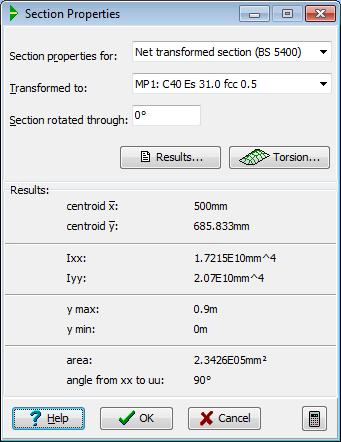Section Properties Analysis
Description
The principal results are displayed (after a comprehensive series of data checks).
More detailed results are available in the printout, which can be viewed on the screen by pressing the F5 key or clicking on the Results button.
Note A
In the calculation of Net Transformed Properties it is possible that the message 'Cannot calculate NA for this section' may appear.
The program calculates the neutral axis height by two different methods. Firstly it performs a linear elastic analysis with no tensile stress in the sections. It then modifies the sections so that the tension area is deducted, and calculates the section properties and corresponding neutral axis height for this cracked section. The error message above occurs when the 2 calculated neutral axis heights do not agree.
There may be 2 reasons why these calculated neutral axis values do not agree:
- If the tolerance for the convergence of the iterations in the linear elastic stress calculation is not sufficiently small, and this causes a corresponding wide tolerance in the neutral axis height.
- If the section would be divided into two parts by deduction of the tension part of the section. This would occur for example in the analysis of a 'U' shaped section.
If the first of these is the case the tolerance can be reduced as described in the topic Set Iteration Convergence Tolerance.
If the second of these is the case, a workaround may be adopted by modelling the section as an outer section and a void for the cut-out of the 'U'. The procedure is as follows:
- Define the U shaped section
- Use 'Copy element' (refer to the topic Edit Toolbar) to make a second identical element.
- Move the second element so that the 2 are superimposed.
- Modify the first element by converting to a User Defined element using Convert To User button to delete all the nodes which form the 'cut-out' part of the U.
- Modify the second element converting to a User Defined element to delete all the nodes which are not part of the 'cut-out' part of the U.
- Assign property type VOID to the second element.
Note B
In the calculation of Plastic Section Properties it is possible that the message 'Cannot calculate plastic section properties for this section' may appear.
This may occur if any shape element in the section would be divided into two parts by deducting the portion of the element above the plastic neutral axis. This would occur for example in the analysis of a hollow section defined using a single element with the split required for defining the void positioned at the bottom of the section shape. The workaround in this case may be to invert the shape so that the split occurs at the top of the element.
Form Graphic

Field Help
Section properties for
Click on this field to display a drop-down list, the first 4 options of which correspond to the options in BS 5400 Part 4 clause 4.4.2.1 and BS 8110 Part 1 clause 2.5.2 as follows:
- The entire member cross section ignoring reinforcement
- The entire member cross section including reinforcement transformed on the basis of modular ratio
- The area of the cross section in compression together with all the tension reinforcement, transformed on the basis of modular ratio (BS 5400)
- The area of the cross section in compression together with all the reinforcement, transformed on the basis of modular ratio (BS 8110)
- The plastic section properties of the cross section
Note that for the first option, as well as ignoring the reinforcement, any different modulus values for different concrete elements are also ignored.
In all cases tendons are ignored. Where both short term and long term values of elastic modulus are specified (i.e. for concrete properties) the short term value is used.
For further guidance refer to BS 8110 Part 2 Clause 3.4.
Transformed to property set ref
This field enables the material property set that will be used as a basis for the modular ratio calculations to be selected. This will normally be the material property set corresponding to the lowest elastic modulus.
Section rotated through
Prior to calculating the section properties, the section will be rotated through the angle specified in this field. Thus, to calculate the net transformed properties for the section in hogging, for example, enter a value of 180°.
Axial
When the analysis is for plastic section properties, this field will be available enabling an axial load to be specified, the presence of which will reduce the plastic moment of resistance. The value may not exceed the plastic squash load, and the program will check and warn if this limit is exceeded.
